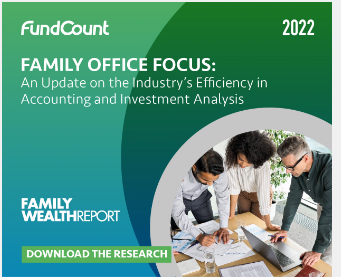WM Market Reports
New Research: An Update On Family Office Efficiency In Accounting, Investment Analysis

This news service is joining forces again with FundCount to examine how technology is making family offices' work processes more efficient and effective.
This publication has proudly partnered once again with FundCount to offer the industry an update on family offices’ progress in efficiency in their accounting and investment analysis work.
Back in 2019, Family Wealth Report/WealthBriefing and FundCount conducted a ground-breaking study of family office efficiency in accounting and investment analysis. Our 2022 update indicates that a great many challenges remain – and that the manual workload facing institutions may have actually worsened quite significantly where technology, not designed specifically for the sector, is still in place.
Family Office Efficiency in Accounting and Investment Analysis: Industry Update is based on surveys and wide-ranging interviews with professionals from institutions which, in over half of instances, represent assets under management in excess of $1 billion. Despite this, 53 per cent of respondents use non-specialist general ledger accounting software, alongside 54 per cent using generalist tools for partnership/investor accounting.
The toll this is taking is clear. On average, the family office professionals who participated in this year’s survey said that they believe 42 per cent of the 40-hour week is wasted on manual processes across all personnel, whereas previously respondents had estimated that only a fifth of the week’s working hours were being expended in this way.
As so many firms struggle with tools that are not designed for the nuances of family office business, those complexities have continued to compound. Almost a quarter (22 per cent) of institutions that are serving just one family have over 26 legal entities in play. For multi-family offices, the challenge is obviously very much larger and commensurate with client numbers, with more than 1,000 entities across 100 families being far from unusual among the biggest institutions we spoke to.
Meanwhile, as investors seek ways to achieve greater diversification and returns, investment tastes continue to trend toward alternatives. Family offices are piling into private equity or hedge funds, direct investments and digital assets – with allocations of 5 per cent to the latter now seeming to be very much the norm. The challenges of accounting for and reporting on non-traditional assets with software not designed for the task will grow dramatically, our contributors have confirmed.
Our study also explored the Key Performance Indicators (KPIs) family offices are using to ensure best response to clients; what the key strengths and weaknesses of their most critical systems are; and what their one “wish list” improvement would be. All in all, this report represents an invaluable benchmark for the sector and an exciting indicator of where technological advances will be taking the sector in the years to come.
Family Office Efficiency in Accounting and Investment Analysis: Industry Update is available for download now. Get your complimentary copy here.